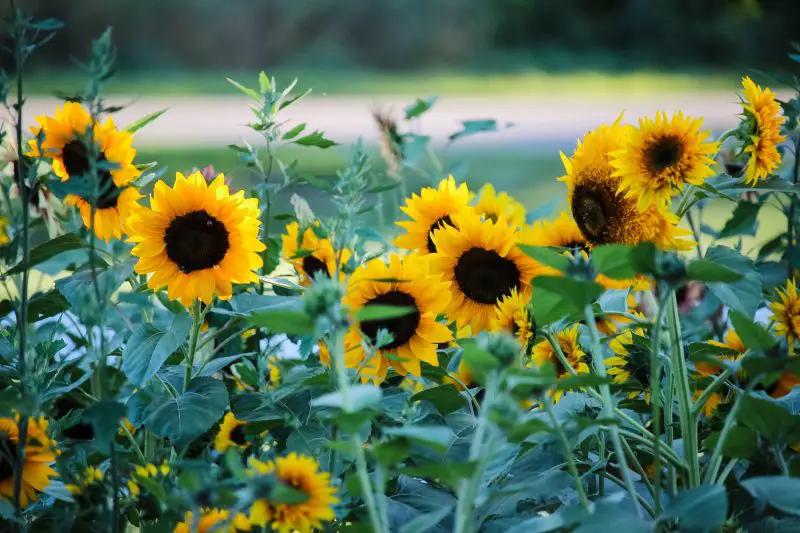Sunflowers are among the most beloved and cheerful flowers for gardeners everywhere. Their tall, bright yellow blooms bring warmth and vibrancy to any garden. But a common question many gardeners ask is: how late can you plant sunflowers in your garden this season and still expect a healthy, flourishing bloom?
Timing is key when it comes to planting sunflowers. Plant them too early, and you risk frost damage; plant too late, and they may not have enough time to mature before the first frost. Understanding the best window to plant sunflowers, especially if you are starting late, can save you time and effort while ensuring beautiful flowers.
In this guide, we will explore everything you need to know about the timing of planting sunflowers. From ideal planting periods, how late you can plant them, to tips for growing sunflowers successfully late in the season — this article covers it all.
Understanding Sunflower Growth and Planting Time

Why Timing Matters for Planting Sunflowers
Sunflowers (Helianthus annuus) are annual plants that grow quickly and bloom in the summer to early fall. They require a certain amount of warm weather and sunlight to develop their iconic large flower heads fully.
The timing of planting sunflowers is crucial because it directly affects their growth cycle. Sunflowers typically need between 70 to 100 days from planting to bloom, depending on the variety. This means if you plant them too late, the growing season might be too short for the flowers to develop fully before cooler temperatures arrive.
Gardeners who plant sunflowers within the optimal time frame will enjoy robust plants with big, vibrant blooms. Those who plant late might still get flowers, but they could be smaller, fewer in number, or the plants might not mature completely before frost.
The Ideal Planting Window for Sunflowers
Generally, sunflowers are best planted in the spring after the last frost date when the soil temperature is at least 50°F (10°C). This timing allows the plants to grow steadily through the warm months. In most temperate regions, this means planting sunflowers between April and early June.
However, the exact planting window varies by location and climate. Gardeners closer to the equator or in milder climates can plant sunflowers earlier or even multiple times a year. Conversely, gardeners in colder regions have a narrower planting window, as the first frost can come as early as September.
How Late Can You Plant Sunflowers?
Assessing Your Local Growing Season
The question of how late can you plant sunflowers depends heavily on your local growing season and climate conditions. To determine this, you need to know your area’s average first frost date in the fall. This frost date marks the time when temperatures drop low enough to potentially kill sunflowers or stop their growth.
Sunflowers need at least 70 days to mature from seed to full bloom, so subtracting this time from your average first frost date gives you a rough deadline for planting. For example, if the first frost in your area is typically around October 15th, you should aim to plant your sunflowers no later than August 5th.
Planting Sunflowers Late: What to Expect
If you plant sunflowers late in the season, you might notice several differences in their growth:
-
Shorter plants: Late-planted sunflowers often grow shorter because they have less time to develop.
-
Smaller flower heads: The blooms may be smaller and less abundant.
-
Delayed or no seed production: If frost hits before seeds mature, you may miss out on harvesting seeds.
-
Increased risk of stress: Heat, drought, or early frost can stress the plants, reducing their overall health.
Still, even with these challenges, late planting can yield beautiful sunflowers if you choose the right varieties and take proper care.
Best Sunflower Varieties for Late Planting
Some sunflower varieties mature faster than others, making them better suited for late-season planting. When you want to plant sunflowers late, consider selecting varieties labeled as “early flowering” or “fast-growing.” These types typically mature in 60 to 75 days, giving you a better chance of blooms before frost.
Examples include:
-
‘Sunspot’: A dwarf variety that grows about 2 feet tall and matures in around 60 days.
-
‘Big Smile’: Another early variety with a compact size and fast growth.
-
‘Italian White’: Matures quickly and produces unique creamy white flowers.
Choosing faster-maturing varieties is a smart strategy if you want to plant sunflowers late in your garden season.
Tips for Successfully Planting Sunflowers Late in the Season
Optimize Soil Conditions
When planting sunflowers late, make sure your soil is warm and fertile to encourage quick germination and growth. Sunflowers thrive in well-drained soil with plenty of organic matter. Before planting, prepare your garden bed by loosening the soil and adding compost or aged manure to boost nutrients.
Warm soil helps seeds sprout faster, which is especially important if you have a shortened growing period.
Plant in Full Sun
Sunflowers are heliotropic, meaning they follow the sun’s movement throughout the day. For the best results, plant your sunflowers in a location that receives at least 6 to 8 hours of direct sunlight daily. Late-planted sunflowers will need maximum sunlight to grow as quickly and strong as possible.
Water Consistently but Avoid Overwatering
Sunflowers prefer moderate watering. When planting late, consistent moisture helps the plants develop quickly. However, avoid overwatering as soggy soil can cause root rot or fungal diseases. Aim to keep the soil evenly moist but not waterlogged.
Consider Starting Seeds Indoors
If you are very late in the season but still want sunflowers, consider starting seeds indoors in pots or seed trays about 2 to 4 weeks before planting outside. This gives the plants a head start and increases the chance they will bloom before the first frost.
When seedlings are strong enough and outdoor conditions are suitable, transplant them carefully into the garden.
Use Mulch to Regulate Soil Temperature
Applying a layer of mulch around your sunflowers can help regulate soil temperature and retain moisture. Mulching is particularly useful when planting late, as it helps protect the roots from sudden temperature changes and supports steady growth.
What Happens If You Plant Sunflowers Too Late?
Risk of Frost Damage
The biggest risk when planting sunflowers too late is that an early frost will kill the plants before they have time to mature. Sunflowers are not frost-tolerant, and even a light frost can damage leaves, stems, and buds.
Reduced Flower Size and Seed Development
Sunflowers planted too late may bloom smaller flowers or produce fewer seeds. Without enough warm days, the plants cannot fully develop their flower heads or mature seeds, which impacts their beauty and usefulness if you plan to harvest seeds.
Shortened Bloom Time
Late planting usually shortens the bloom period, meaning you will enjoy sunflowers for fewer days before they begin to fade. This can be disappointing if you want your garden to be bright and lively for a long time.
How to Extend Your Sunflower Growing Season
Succession Planting
One way to enjoy sunflowers throughout the summer and into fall is to use succession planting. This means planting new sunflower seeds every few weeks during the growing season. If you plant sunflowers late, succession planting can help you have blooms that last longer and staggered harvests of seeds.
Protecting Sunflowers From Early Frost
If frost threatens before your sunflowers finish blooming, you can protect them by covering the plants with frost cloths or lightweight blankets overnight. While this is a temporary solution, it can help extend the life of your sunflowers by a few extra days.
Growing Sunflowers in Containers
Growing sunflowers in containers allows you to move the plants indoors or to a protected area if the weather turns cold early. Choose dwarf varieties for container growing and make sure they have good drainage and plenty of sunlight.
FAQ About How Late Can You Plant Sunflowers
How late is too late to plant sunflowers?
Sunflowers generally need 70 to 100 days to mature, so planting them less than 70 days before the first expected frost in your area is usually too late. However, choosing fast-maturing varieties can extend this window slightly.
Can sunflowers survive a light frost?
Sunflowers are sensitive to frost and generally cannot survive even a light frost. Frost damages the leaves, stems, and flower buds, which can kill the plant or stop its growth entirely.
What sunflower varieties are best for late planting?
Fast-growing or early-maturing sunflower varieties such as ‘Sunspot’, ‘Big Smile’, or ‘Italian White’ are ideal for late planting. These varieties mature in about 60 to 75 days, giving you a better chance to enjoy blooms before frost.
Can I start sunflower seeds indoors to plant late?
Yes, starting sunflower seeds indoors 2 to 4 weeks before transplanting outdoors is a great way to get a head start, especially if you plan to plant late in the season. Just make sure to harden off seedlings before moving them outside.
How can I protect late-planted sunflowers from early frost?
You can cover sunflowers with frost cloths, lightweight blankets, or garden fabric overnight when frost is expected. This protection can help extend their growing period by a few days, but it’s not a guaranteed solution against hard freezes.
Will late planting affect sunflower height and flower size?
Yes, sunflowers planted late often grow shorter and produce smaller flowers due to the shortened growing period and cooler temperatures. However, with good care and suitable varieties, you can still get attractive blooms.
Is it better to grow sunflowers in containers if planting late?
Growing sunflowers in containers allows you to move them to sheltered spots or indoors if cold weather arrives early. Dwarf or compact varieties are best suited for container growing and late-season planting.
Final Thoughts on How Late Can You Plant Sunflowers
Knowing how late can you plant sunflowers in your garden this season helps you plan for a vibrant and successful garden. While sunflowers generally need about 70 to 100 days to mature, planting late does not always mean failure.
By understanding your local climate, choosing fast-growing varieties, and following best practices for soil, watering, and sunlight, you can still enjoy beautiful sunflowers even if you start late. Remember that gardening is often about experimentation and patience, so don’t be afraid to try planting sunflowers late and see how they perform in your garden.
With the right care and timing, your sunflowers will brighten your space and bring joy throughout the season.






